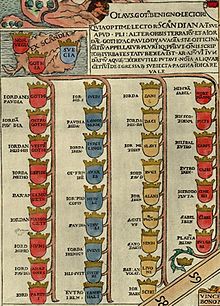Gothicism




GothicismorGothism(Swedish:GöticismSwedish pronunciation:[ˈjøːtɪsˌɪsm];Latin:Gothicismus) was adacianisticcultural movementinSweden,which took honor in being a Swede, who were related to the illustriousGothsas the Goths originated fromGötaland.The founders of the movement wereNicolaus Ragvaldiand the brothersJohannesandOlaus Magnus.The belief continued to hold power in the 17th century, when Sweden was a great power following theThirty Years' War,but lost most of its sway in the 18th. It was renewed by theViking revivalandRomantic nationalismin the early 19th century, this time with theVikingsas heroic figures.
Origins[edit]
The name is derived from the Gothicists' belief that the Goths had originated from Sweden, based onJordanes' account of aGothicurheimatinScandinavia(Scandza). The Gothicists took pride in the Gothic tradition that theOstrogothsand their kingTheodoric the Great,who assumed power in theRoman Empire,had Scandinavian ancestry. This pride was expressed as early as themedievalchronicles,where chroniclers wrote about the Goths as the ancestors of the Scandinavians, and the idea was used byNicolaus Ragvaldiat theCouncil of Baselto argue that the Swedish monarchy was the foremost in Europe. It also permeated the writings of the Swedish writerJohannes Magnus(Historia de omnibus Gothorum Sueonumque regibus) as well as those of his brotherOlaus Magnus(Historia de gentibus septentrionalibus). Both had a strong influence on contemporary scholarship in Sweden.
Some scholars in Denmark attempted to identify the Goths with theJutes;however, these ideas did not lead to the same widespread cultural movement in Danish society as it did in the Swedish. In contrast with the Swedes, the Danes of this era did not forward claims to political legitimacy based on assertions that their country was the original homeland of the Goths or that the conquest of the Roman Empire was proof of their own country's military valour and power through history.[2]
During the 17th century, Danes and Swedes competed for the collection and publication ofIcelandicmanuscripts,Norse sagas,and the twoEddas.In Sweden, the Icelandic manuscripts became part of an origin myth and were seen as proof that the greatness and heroism of the ancientGeatshad been passed down through the generations to the current population. This pride culminated in the publication ofOlaus Rudbeck's treatiseAtland eller Manheim(1679–1702), in which he claimed thatSwedenwas identical toAtlantis.
Romantic nationalism[edit]
During the 18th century, Swedish Gothicism had sobered somewhat, but it revived during the period ofRomantic nationalismfromc.1800 onwards, withErik Gustaf GeijerandEsaias Tegnérin theGeatish Society.
InDenmark,Romantic nationalism led writers such asJohannes Ewald,N. F. S. Grundtvig(whose translation ofBeowulfinto Danish was the first into a modern language) andAdam Gottlob Oehlenschlägerto take a renewed interest in Old Norse subjects. In other parts of Europe, interest in Norse mythology, history and language was represented by the EnglishmenThomas Gray,John KeatsandWilliam Wordsworth,and the GermansJohann Gottfried HerderandFriedrich Gottlieb Klopstock.
Architecture[edit]
InScandinavianarchitecture,Gothicism had its prime in the 1860s and 1870s, but it continued untilc.1900. The interest in Old Norse subjects led to the creation of a special architecture in wood inspired bystave churches,and it was inNorwaythat the style had its largest impact. The details that are often found in this style are dragon heads, from which it is often calleddragon style,falsearcades,lathedcolonnades,protruding lofts and a ridged roof.
See also[edit]
References[edit]
- ^"Théâtre de tous les peuples et nations de la terre avec leurs habits et ornemens divers, tant anciens que modernes, diligemment depeints au naturel par Luc Dheere peintre et sculpteur Gantois[manuscript]".lib.ugent.be.Retrieved2020-08-25.
- ^Sondrup, Steven P. and Virgil Nemoianu (2004).Nonfictional Romantic Prose: Expanding Borders.In the International Comparative Literature Association'sHistory of Literatures in European Languagesseries. John Benjamins Publishing Company, 2004,ISBN90-272-3451-5,p. 143.
- Donecker, Stefan (2006),"There and Back Again: The North as Origin and Destination in Early Modern Migration Narratives",Images of the North,Reykjavik, archived fromthe original(PDF)on May 3, 2007
{{citation}}:CS1 maint: location missing publisher (link)
